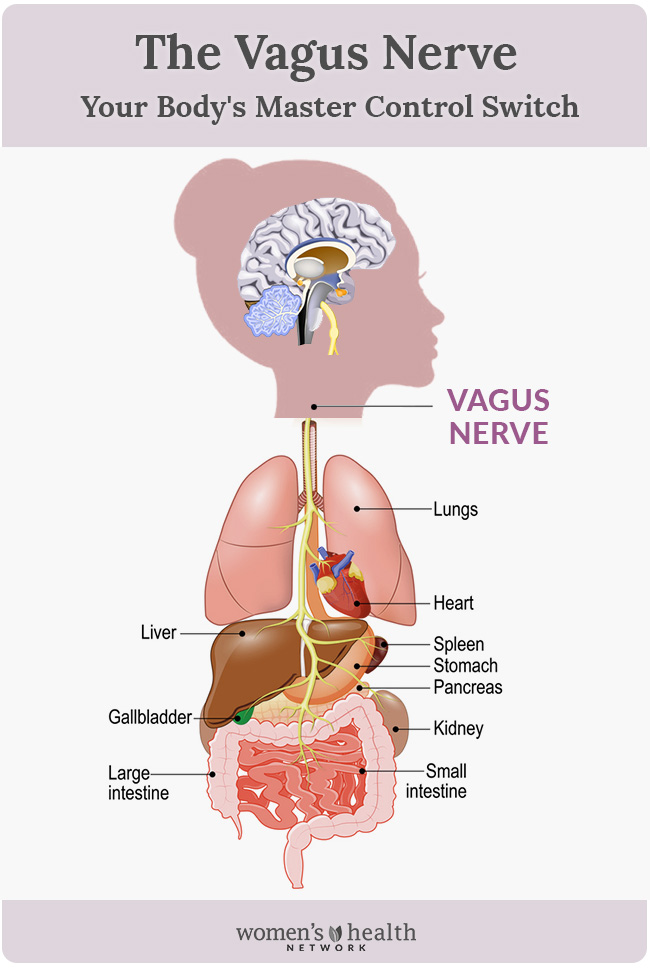Authored by Dr. Sharon Stills, NMD
When people are under chronic stress, the body’s fight-or-flight response becomes constantly engaged, sending cortisol levels higher and triggering the body’s sympathetic nervous system. That part of the nervous system responds to stress with rapid and shallow breathing, constricted blood vessels and increased heart rate.

If you often find yourself in an antsy, agitated mood, with that heart-racing-jumping-out-of-your-skin feeling, there’s a good chance that excess stress has you “stuck” in your sympathetic nervous system. To get unstuck, you need to give your body support to activate its parasympathetic nervous system — the part of the nervous system that boosts emotional resilience by helping the body recover and heal from stress.
One of the most powerful ways to switch off your stress response and switch on your parasympathetic nervous system is to stimulate the body’s Vagus nerve. Extending from the brain through the face and neck to the abdomen and GI tract, the body’s Vagus nerve is considered a miraculous nexus that maintains a kind of balancing act between your stress response (the sympathetic nervous system) and your healing response (the parasympathetic).

When the Vagus nerve is activated, it shifts the balance to the parasympathetic, putting the brakes on the body’s stress reflex. As a result, blood vessels relax and widen, creating a greater sense of calm.
Best of all, you can activate your Vagus nerve in a number of simple ways.
1. Belly breathing to activate the Vagus nerve
One of the easiest ways to activate the Vagus nerve is deep “belly” breathing. The rhythmic action of deep breathing stimulates the nerve endings in the abdomen.
Get started with slow abdominal breathing with just a few steps:
- Sit upright in a chair or lie on your back on a yoga mat or in bed, with your knees bent and your head supported with a low pillow.
- Place one hand on your upper chest and the other on your belly, just below your rib cage.
- Breathe in slowly through your nose, drawing the air in deeply towards your lower belly. The hand on your chest should remain still at first, while the one on your belly should rise.
- Exhale slowly through pursed lips. The hand on your belly should move down to its original position.
- The inhale and exhale should both be relaxed, but make sure the exhale is longer than the inhale.
Practice this breathing pattern for at least 10 minutes a day. If it’s been a high stress day, take a few extra deep breathing breaks to help you maintain calm. The relaxed state of mind you feel after deep breathing makes it that much easier to deal with everyday stressors.
2. Take a “cold plunge”
Research shows that cold-water immersion may help with stress by slowing your heart rate and directing blood flow to your brain where it provides stimulation to the Vagus nerve.
For beginners, an easy way to experiment with cold therapy is to turn the water colder for the final 30 seconds of your morning shower, then gradually work up to taking a completely cold shower for a few minutes. Cold-plunging also supports healthy immune function, improved mood, better circulation and reduced inflammation. If you need a baby step to help you ease into cold-plunging, try dipping your face in a large bowl of cold water for a few seconds at a time.
3. Chanting and meditation
Other ways to stimulate the Vagus nerve include chanting and meditation that uses a spoken mantra — both of these practices are so good for stress relief, partly because they stimulate the Vagus nerve endings in the back of the throat that help you to enter a deep state of relaxation. Try working a 10- or 20-minute meditation time into your morning routine. Gargling can also stimulate Vagus nerve endings in the throat.
4. Ear massage to stimulate the Vagus nerve
The Vagus nerve also touches the ear. You can stimulate this nerve ending by placing your finger in the hollow of the “cymba conchae” (that deep curve of the outer ear) and gently rubbing the skin in a circular pattern whenever you feel stressed.
5. Reflexology massage
Researchers have found that reflexology foot massage assists in stimulating the Vagus nerve and can even lower blood pressure, likely through signaling to the brain, which in turn activates the nerve. For an easy reflexology technique, rub the sole of each foot with alternating gentle and firm touches while stretching your toes.
More reasons to care about your Vagus nerve
Turning on your Vagus nerve is a powerful tool for fighting stress, but that’s not all this “wandering nerve” can do for your health! We’re constantly learning more about other benefits of regular stimulation of the Vagus nerve. These include boosting mood, reducing inflammation, lowering heart rate and even providing relief for migraine headaches. Exciting research is ongoing in all these areas and we look forward to sharing more about this miraculous nerve. In the meantime, take a few minutes to breathe, hum and splash a little cold water on your face to feel your stress melt away.











